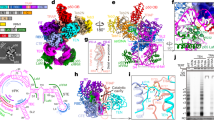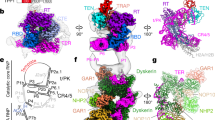Abstract
Telomerase contains a large RNA subunit, TER, and a protein catalytic subunit, TERT. Whether telomerase functions as a monomer or dimer has been a matter of debate. Here we report biochemical and labeling data that show that in vivo–assembled human telomerase contains two TERT subunits and binds two telomeric DNA substrates. Notably, catalytic activity requires both TERT active sites to be functional, which demonstrates that human telomerase functions as a dimer. We also present the three-dimensional structure of the active full-length human telomerase dimer, determined by single-particle EM in negative stain. Telomerase has a bilobal architecture with the two monomers linked by a flexible interface. The monomer reconstruction at 23-Å resolution and fitting of the atomic structure of the TERT subunit from beetle Tribolium castaneum into the EM density reveals the spatial relationship between RNA and protein subunits, providing insights into telomerase architecture.
This is a preview of subscription content, access via your institution
Access options
Subscribe to this journal
Receive 12 print issues and online access
$189.00 per year
only $15.75 per issue
Buy this article
- Purchase on Springer Link
- Instant access to full article PDF
Prices may be subject to local taxes which are calculated during checkout





Similar content being viewed by others
References
de Lange, T. How telomeres solve the end-protection problem. Science 326, 948–952 (2009).
Harley, C.B. Telomerase and cancer therapeutics. Nat. Rev. Cancer 8, 167–179 (2008).
Greider, C.W. & Blackburn, E.H. A telomeric sequence in the RNA of Tetrahymena telomerase required for telomere repeat synthesis. Nature 337, 331–337 (1989).
Yu, G.L., Bradley, J.D., Attardi, L.D. & Blackburn, E.H. In vivo alteration of telomere sequences and senescence caused by mutated Tetrahymena telomerase RNAs. Nature 344, 126–132 (1990).
Cech, T.R. Beginning to understand the end of the chromosome. Cell 116, 273–279 (2004).
Lingner, J. et al. Reverse transcriptase motifs in the catalytic subunit of telomerase. Science 276, 561–567 (1997).
Blackburn, E.H. & Collins, K. Telomerase: an RNP enzyme synthesizes DNA. Cold Spring Harb. Perspect. Biol. 3, a003558 (2011).
Weinrich, S.L. et al. Reconstitution of human telomerase with the template RNA component hTR and the catalytic protein subunit hTRT. Nat. Genet. 17, 498–502 (1997).
Autexier, C. & Lue, N. The structure and function of telomerase reverse transcriptase. Annu. Rev. Biochem. 75, 493–517 (2006).
Cohen, S.B. et al. Protein composition of catalytically active human telomerase from immortal cells. Science 315, 1850–1853 (2007).
Egan, E.D. & Collins, K. Specificity and stoichiometry of subunit interactions in the human telomerase holoenzyme assembled in vivo. Mol. Cell Biol. 30, 2775–2786 (2010).
Venteicher, A.S. et al. A human telomerase holoenzyme protein required for Cajal body localization and telomere synthesis. Science 323, 644–648 (2009).
Errington, T.M., Fu, D., Wong, J.M. & Collins, K. Disease-associated human telomerase RNA variants show loss of function for telomere synthesis without dominant-negative interference. Mol. Cell Biol. 28, 6510–6520 (2008).
Wenz, C. et al. Human telomerase contains two cooperating telomerase RNA molecules. EMBO J. 20, 3526–3534 (2001).
Arai, K. et al. Two independent regions of human telomerase reverse transcriptase are important for its oligomerization and telomerase activity. J. Biol. Chem. 277, 8538–8544 (2002).
Beattie, T.L., Zhou, W., Robinson, M.O. & Harrington, L. Functional multimerization of the human telomerase reverse transcriptase. Mol. Cell Biol. 21, 6151–6160 (2001).
Moriarty, T.J., Huard, S., Dupuis, S. & Autexier, C. Functional multimerization of human telomerase requires an RNA interaction domain in the N terminus of the catalytic subunit. Mol. Cell Biol. 22, 1253–1265 (2002).
Gardano, L., Holland, L., Oulton, R., Le Bihan, T. & Harrington, L. Native gel electrophoresis of human telomerase distinguishes active complexes with or without dyskerin. Nucleic Acids Res. 40, e36 (2012).
Sekaran, V.G., Soares, J. & Jarstfer, M. Structures of telomerase subunits provide functional insights. Biochim. Biophys. Acta 1804, 1190–1201 (2010).
Wyatt, H., West, S. & Beattie, T. InTERTpreting telomerase structure and function. Nucleic Acids Res. 38, 5609–5622 (2010).
Zhang, Q., Kim, N.K. & Feigon, J. Architecture of human telomerase RNA. Proc. Natl. Acad. Sci. USA 108, 20325–20332 (2011).
Mitchell, M., Gillis, A., Futahashi, M., Fujiwara, H. & Skordalakes, E. Structural basis for telomerase catalytic subunit TERT binding to RNA template and telomeric DNA. Nat. Struct. Mol. Biol. 17, 513–518 (2010).
Schuller, A.P., Harkisheimer, M.J. & Skordalakes, E. In vitro reconstitution of the active T. castaneum telomerase. J. Vis. Exp. e2799 (2011).
Kohlstaedt, L.A., Wang, J., Friedman, J., Rice, P. & Steitz, T. Crystal structure at 3.5 Å resolution of HIV-1 reverse transcriptase complexed with an inhibitor. Science 256, 1783–1790 (1992).
Gillis, A.J., Schuller, A. & Skordalakes, E. Structure of the Tribolium castaneum telomerase catalytic subunit TERT. Nature 455, 633–637 (2008).
Jacobs, S.A., Podell, E. & Cech, T. Crystal structure of the essential N-terminal domain of telomerase reverse transcriptase. Nat. Struct. Mol. Biol. 13, 218–225 (2006).
Theimer, C.A. & Feigon, J. Structure and function of telomerase RNA. Curr. Opin. Struct. Biol. 16, 307–318 (2006).
Mitchell, J.R. & Collins, K. Human telomerase activation requires two independent interactions between telomerase RNA and telomerase reverse transcriptase. Mol. Cell 6, 361–371 (2000).
Kelleher, C., Teixeira, M., Forstemann, K. & Lingner, J. Telomerase: biochemical considerations for enzyme and substrate. Trends Biochem. Sci. 27, 572–579 (2002).
Cristofari, G. et al. Low- to high-throughput analysis of telomerase modulators with Telospot. Nat. Methods 4, 851–853 (2007).
Cristofari, G. & Lingner, J. Telomere length homeostasis requires that telomerase levels are limiting. EMBO J. 25, 565–574 (2006).
Mitchell, J.R., Wood, E. & Collins, K. A telomerase component is defective in the human disease dyskeratosis congenita. Nature 402, 551–555 (1999).
Howarth, M. et al. A monovalent streptavidin with a single femtomolar biotin binding site. Nat. Methods 3, 267–273 (2006).
Hahn, W.C. et al. Inhibition of telomerase limits the growth of human cancer cells. Nat. Med. 5, 1164–1170 (1999).
Kastner, B. et al. GraFix: sample preparation for single-particle electron cryomicroscopy. Nat. Methods 5, 53–55 (2008).
Scheres, S.H. et al. Modeling experimental image formation for likelihood-based classification of electron microscopy data. Structure 15, 1167–1177 (2007).
Rosenthal, P.B. & Henderson, R. Optimal determination of particle orientation, absolute hand, and contrast loss in single-particle electron cryomicroscopy. J. Mol. Biol. 333, 721–745 (2003).
Gardano, L., Holland, L., Oulton, R., Le Bihan, T. & Harrington, L. Native gel electrophoresis of human telomerase distinguishes active complexes with or without dyskerin. Nucleic Acids Res. 40, e36 (2012).
Alves, D. et al. Single-molecule analysis of human telomerase monomer. Nat. Chem. Biol. 4, 287–289 (2008).
Canudas, S. et al. A role for heterochromatin protein 1γ at human telomeres. Genes Dev. 25, 1807–1819 (2011).
Fouché, N., Moon, I.K., Keppler, B.R., Griffith, J.D. & Jarstfer, M.B. Electron microscopic visualization of telomerase from Euplotes aediculatus bound to a model telomere DNA. Biochemistry 45, 9624–9631 (2006).
Nunez-Ramirez, R. et al. Flexible tethering of primase and DNA Pol α in the eukaryotic primosome. Nucleic Acids Res. 39, 8187–8199 (2011).
Ren, X. et al. Identification of a new RNA·RNA interaction site for human telomerase RNA (hTR): structural implications for hTR accumulation and a dyskeratosis congenita point mutation. Nucleic Acids Res. 31, 6509–6515 (2003).
Graham, F.L., Smiley, J., Russell, W. & Nairn, R. Characteristics of a human cell line transformed by DNA from human adenovirus type 5. J. Gen. Virol. 36, 59–74 (1977).
Cristofari, G. et al. Human telomerase RNA accumulation in Cajal bodies facilitates telomerase recruitment to telomeres and telomere elongation. Mol. Cell 27, 882–889 (2007).
Cohen, S.B. et al. Protein composition of catalytically active human telomerase from immortal cells. Science 315, 1850–1853 (2007).
Kastner, B. et al. GraFix: sample preparation for single-particle electron cryomicroscopy. Nat. Methods 5, 53–55 (2008).
Wenz, C. et al. Human telomerase contains two cooperating telomerase RNA molecules. EMBO J. 20, 3526–3534 (2001).
Cristofari, G. et al. Low- to high-throughput analysis of telomerase modulators with Telospot. Nat. Methods 4, 851–853 (2007).
Acknowledgements
We thank P. Reichenbach, B. Zuber, S.J. Ludtke, R. Henderson, J. Short, J. Grimmett, S. Chen and A. Christen for help and advice, S. Thurnheer and D. Hacker for telomerase production, and P. Hunziker for protein identification. We thank the Human Frontier Science Program for funding through a grant (RGP0032/2005-C) awarded to J.L. and D.R. and a post-doctoral fellowship to A.S.; the European Molecular Biology Organization for post-doctorial fellowships to A.S. and S.S.; and the UK Medical Research Council for a career-development fellowship to S.S. Work in J.L.'s laboratory is supported by the Swiss National Science Foundation and a European Research Council advanced investigator grant (232812). Work in D.R.'s and S.H.W.S.'s laboratory is supported by the UK Medical Research Council (U10518433333 and MC_UP_A025_1013, respectively.).
Author information
Authors and Affiliations
Contributions
A.S. designed and carried out all the biochemical work and contributed to image processing. S.S. collected EM data and solved the structures. G.C. developed the super-telomerase cells. S.H.W.S designed and contributed to the structure refinement. J.L. and D.R. designed and supervised the project. All authors contributed to the writing of the paper.
Corresponding authors
Ethics declarations
Competing interests
The authors declare no competing financial interests.
Supplementary information
Supplementary Text and Figures
Supplementary Figures 1–5, Supplementary Table 1 and Supplementary Note (PDF 1559 kb)
Supplementary Movie 1
Juxtaposition of the two 2D class average images suggests that telomerase has a flexible dimer interface. (MOV 238 kb)
Rights and permissions
About this article
Cite this article
Sauerwald, A., Sandin, S., Cristofari, G. et al. Structure of active dimeric human telomerase. Nat Struct Mol Biol 20, 454–460 (2013). https://doi.org/10.1038/nsmb.2530
Received:
Accepted:
Published:
Issue Date:
DOI: https://doi.org/10.1038/nsmb.2530
This article is cited by
-
Cryo-EM structures tell a tale of two telomerases
Nature Structural & Molecular Biology (2021)
-
Observation of processive telomerase catalysis using high-resolution optical tweezers
Nature Chemical Biology (2020)
-
Targeting telomerase for cancer therapy
Oncogene (2020)
-
Detailed view of human telomerase enzyme invites rethink of its structure
Nature (2018)
-
New prospects for targeting telomerase beyond the telomere
Nature Reviews Cancer (2016)



